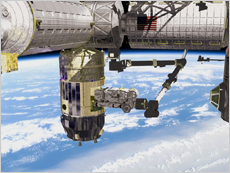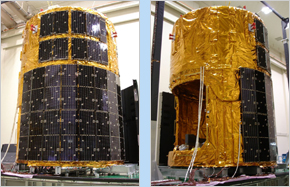

The HTV's exposed pallet brought out by the robotic arm (Artist's Concept)
Ideas of the HTV started in the 1980s, when Japan decided to participate in the ISS program, with the least anticipation that the Space Shuttle would be retired. Once the space shuttle is no longer available, only the HTV will be able to deliver some of the Orbital Replacement Unit (ORU) that's essential to the space station's operation. Thus the importance of the HTV was widely recognized when the Shuttle retirement was announced.
After the United States announced in 2004 that the Space Shuttle would be retired in 2010, the success of the HTV suddenly became much more crucial, because the HTV is the only transport vehicle, which could fulfill some of Shuttle's critical functions. For example, the European ATV cannot carry large components such as the main ISS batteries and the attitude control system, which will be delivered in HTV's unpressurized carrier. For this reason, the opening of the ULC measures 2.7 by 2.5 meters. Such a large opening reduces the strength of the structure, so advanced technology had to be developed to construct the HTV.
Another advantage of the HTV is its 1.2 by 1.2 meters square hatch, which is larger than ATV's round hatch with a diameter of only 0.8 meter. Although HTV's cargo capacity is smaller than ATV's, its larger hatch size allows it to carry large objects such as experiment devices.
On the other hand, the ATV does have its advantages over the HTV. The ISS's altitude is gradually decreasing due to air drag from Earth's upper atmosphere. While the Space Shuttle and Progress are docking with the ISS, they periodically use their jet engines to adjust the ISS altitude. The ATV also has this ability, while the HTV does not. In addition, the ATV can supply fuel to the ISS. We would like the HTV to contribute to the operation of the ISS alongside the ATV and Progress, while maximizing the utility of each spacecraft's special features.

The HTV Proto-Flight Model (The PLC and ULC are connected)
The first HTV (the Proto-Flight Model), which will be launched in 2009, is almost completed. In September 2008, we finished the Thermal Vacuum Test to simulate the thermal environment in orbit, followed by a test to examine whether the spacecraft can withstand the vibrations and acoustic environment during launch. Currently, a functional test is being performed to check the effects from these environmental tests. After this is completed, the HTV will be transported to the Tanegashima Space Center in spring, and will start final preparations for launch.
The role of the first HTV is not only to demonstrate the vehicle's function and performance, but it will also deliver supplies to the ISS. The first HTV will load more batteries and propellants than its subsequent in order to have enough resources to perform several first flight demonstrations and solve any potential problems. The HTV can normally carry 6 tons of cargos, but because of these tests, it will be launched with only 4.5 tons, with the rest of its payload consisting of the additional batteries and propellants.
The launch of the HTV is fast approaching, so we would like to perform all the possible tests on the ground and conduct the actual launch with confidence.

H-II Transfer Vehicle (HTV)
HTV's present purpose is to deliver supplies to the ISS and burn unneeded items during re-entry to the atmosphere, but there are other possibilities for utilization in addition to transportation missions. As its name suggests, the Transfer Vehicle, also known as an orbital transporter, is a spacecraft, and can travel freely in space. Thus it may be able to test transmission capability in space with the ISS and other satellites, and perform micro-gravity experiments in an unmanned environment, which is free from any disturbance caused by the presence of human beings affecting the micro-gravity environment. It could also carry out Earth observations from a low altitude and transport a recovery capsule to bring back samples used in experiments on the ISS.
There are four principal elements needed for manned spacecraft: propulsion control, a pressurized vessel with air, a return capsule to bring the astronauts back to Earth, and an emergency evacuation system. The HTV has two of these - propulsion control and a pressurized vessel with air. To use a similar vehicle for manned transport, we would have to add a return capsule and an emergency evacuation system. And to go to more distant places such as the Moon and Mars, we would also have to add a life support system. Although the development of the HTV and H-IIB Launch Vehicle has laid the groundwork for manned spacecraft, to reach that goal, we would still need to improve their reliability and safety.
Related Link: H-II Transfer Vehicle (HTV)
Yoshihiko Torano
Project Manager, HTV Project Team, JAXA Human Space Systems and Utilization Mission Directorate
Mr. Torano joined NASDA (now part of JAXA) in 1974, upon graduation from Osaka Prefecture University. He worked in the launch control department, notably as Launch Conductor for the N-I and N-II Launch Vehicles, including work at the Tanegashima Space Center. After participating in the development of the H-I Launch Vehicle and the launch pad of the H-IIA Launch Vehicle, he was posted as a Project Manager for the J-I Launch Vehicle Project in 2000, then as a Sub-Manager for the H-IIA Launch Vehicle Project in 2004, followed by his current post in 2005.
Project Manager, HTV Project Team, JAXA Human Space Systems and Utilization Mission Directorate
Mr. Torano joined NASDA (now part of JAXA) in 1974, upon graduation from Osaka Prefecture University. He worked in the launch control department, notably as Launch Conductor for the N-I and N-II Launch Vehicles, including work at the Tanegashima Space Center. After participating in the development of the H-I Launch Vehicle and the launch pad of the H-IIA Launch Vehicle, he was posted as a Project Manager for the J-I Launch Vehicle Project in 2000, then as a Sub-Manager for the H-IIA Launch Vehicle Project in 2004, followed by his current post in 2005.
The H-IIB Launches a New Rocket Era in Japan
H-IIB Launch Vehicle: Designed for World-Class Launch Capability
The Next Step in Japan's Space Development
HTV: An Indispensable Part of ISS Operations
H-IIB Launch Vehicle: Designed for World-Class Launch Capability
The Next Step in Japan's Space Development
HTV: An Indispensable Part of ISS Operations